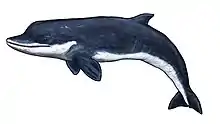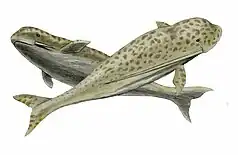| Miophocaena Temporal range: Late Miocene 6.4–5.5 Ma | |
|---|---|
| Scientific classification | |
| Domain: | Eukaryota |
| Kingdom: | Animalia |
| Phylum: | Chordata |
| Class: | Mammalia |
| Order: | Artiodactyla |
| Infraorder: | Cetacea |
| Family: | Phocoenidae |
| Genus: | †Miophocaena Murakami, Shimada, Hikida, and Hirano, 2012 |
| Species: | †M. nishinoi |
| Binomial name | |
| †Miophocaena nishinoi Murakami, Shimada, Hikida, and Hirano, 2012 | |
Miophocaena nishinoi is an extinct species of porpoise from the Late Miocene Koetoi Formation of Japan, dating to around 6.4–5.5 million years ago (mya), represented by a partial skull. the genus name derives from Ancient Greek mio for the Miocene, and phocaena for "porpoise"; the species name honors the discoverer, Takanobu Nishino. Miophocaena resides in a clade with Archaeophocaena discovered in the same area, and, along with Pterophocaena, represents an intermediate phase between porpoises and dolphins.[1]
References
- ↑ Murakami, M.; Shimada, C.; Hikida, Y.; Hirano, H. (2012). "Two new extinct basal phocoenids (Cetacea, Odontoceti, Delphinoidea), from the upper Miocene Koetoi Formation of Japan and their phylogenetic significance". Journal of Vertebrate Paleontology. 32 (5): 1172–1185. doi:10.1080/02724634.2012.694337. S2CID 84268028.
This article is issued from Wikipedia. The text is licensed under Creative Commons - Attribution - Sharealike. Additional terms may apply for the media files.

